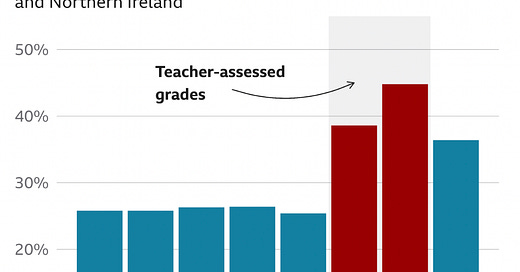A levels: Top grades fall as students react to their results.
An assessment of this year's A level results and what to expect for GCSE results on the 25th of August.
A Level Results
Finally, A level results have been released on the 18th of August to the hundreds of thousands taking them this year. For this cohort, it is the first time they have sat public exams, after two years of cancellations due to the Covid pandemic.
Only about 36.4% of A levels were marked at A/A* this year, whilst last year it was 44.8% of exams were at this standard. This is due to the immense grade inflation which was seen due to teacher assessed grades.
Of course, this has had quite irritable consequences for students as they hope to get into their dream university. UCAS (University and College Admissions Service) has stated only 65.3% of students in the UK, who had applied, got into their first choice university (20,360 students had not got into university at all).
This year grades reflect the mid point between 2019 - when 25.4% of grades was A and above - and 2021, one of the two years where there was an inflation of grades.
What to expect for GCSE results next week (25/08/22)
This year’s grades are going to be just a little different form the past years, there will be generous grading. Well, what is generous grading ?
Grade boundaries are made after every student has taken their exam and has been marked. This is to ensure that if all the students find any question or paper particularly hard, the grade boundaries can be adjusted so that a mark ‘6’ is the same as a mark ‘6’ in previous years, so they can be comparable.
Obviously, there has been a major pandemic so this year will be a bit different. Generous grading is done in order to advantage the 2022 students compared to the 2019 students who had sat the exams without a world wide pandemic. This is also done because it will not disadvantage the 2022 students to the 2021 students who had grades given to them due to centre assessed grades, overall being highly inflated.
This generous grading will work as they shift the bell curve slightly, meaning more people will get A* and more people will be getting grade 9s than maybe if you sat the exams in 2019. However, what this means for grade boundaries may be slightly different.
With all this information, you may think that grade boundaries will go down, which seems reasonable. However, this may not be the case. The fact that there was help for the students, such as advanced information and equation sheets, may mean that many students do really well. For example, if everyone gets 90 percent in an exam, the exam board can’t afford for all of them to get a A* or ‘9’, so the grade boundaries will grow exponentially in order to make this bell curve of results.
Concluding, there will be generous grading, which is moving the bell curve - making more students getting 9s, in order to prevent coming off worse to the 2021 students. This, however, will not necessarily mean that grade boundaries are going to be any lower due to the help given to the students, resulting in naturally higher performances.



